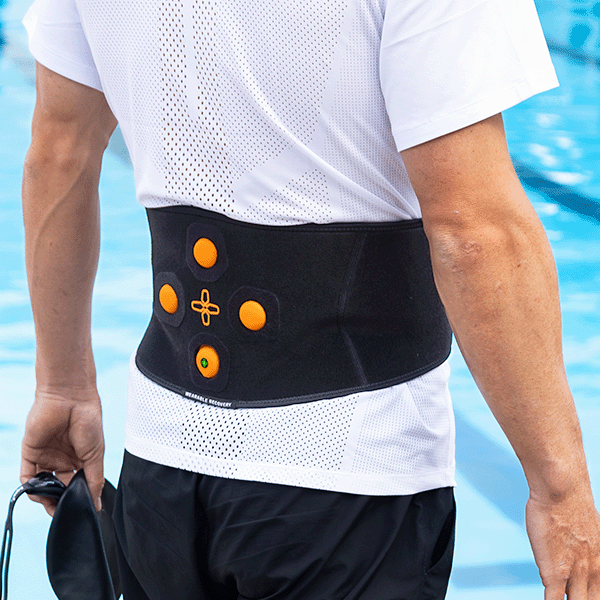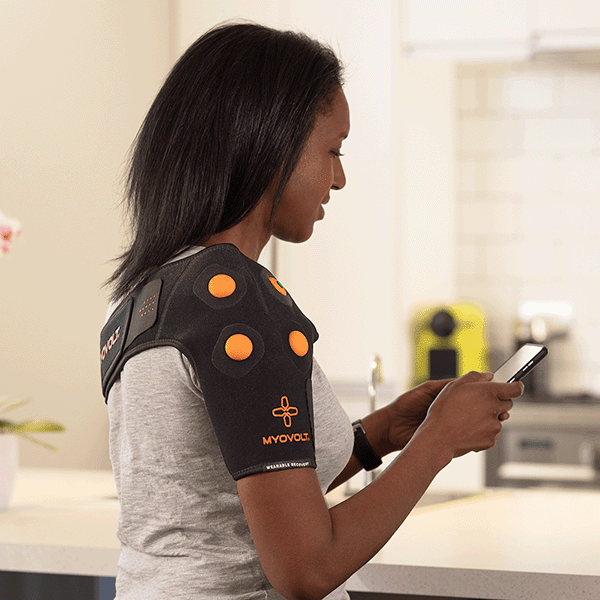Harnessing technology for sports injury rehab.
Q&A with Dr Kenneth Vincent DPM.
Medical Director Kompass Health.
Harnessing Technology for Sports Injury Rehabilitation.
An Interview with Dr Kenneth Vincent DPM.
Medical Director Kompass Health.
Imagine a world where peak performance is within reach for everyone, athletes and individuals alike. This is the vision that drives us at Myovolt and it is a goal shared by Dr Kenneth Vincent DPM, a leading authority in sports performance optimization and injury rehabilitation.
Ken has been on the front lines of sports medicine for the last decade, giving training workshops and lectures in more than 28 countries. He works closely with a global network of associate physicians and sports scientists and serves as a specialist consultant at the Al-Methali Rehabilitation Centre in Muscat. He is also Medical Director of Kompass Health in Oman and one of Myovolt's valued practitioners.
In this conversation Ken shares his knowledge gained from hands-on experience over many years working with some of the world's top athletes. He also discusses the role that advanced technologies play to support his approach to diagnosing and treating sports related injuries.
Q. Ken, tell us a little about your work and the different sports you have been involved with over the last 10 years?
I have been involved in sports rehabilitation and performance optimization since 2002. Over the years I have had the pleasure of working with athletes from over 13 different countries, across 25 sporting disciplines including soccer, rugby, track & field, tennis, golf and speed skating.
I primarily use a specialized acousticwave modality for musculoskeletal treatment called Electrohydraulic Shock Wave Therapy. I have conducted lectures, workshops, and written publications on this topic. I was the vice-president and president of the International Society for Medical Shockwave Treatment (2015 – 2018).
Q. You have travelled extensively, what have been the highlights working with international athletes and teams?
Every athlete is important to me, I remember the very first whom I treated in 2002, an elite hockey player with a tibia compression fracture. Over the years I have treated both amateur and international superstars for both injury recovery and performance optimization. This includes Kiwis: Lydia Ko, Ali Williams, Grant Elliot, Samantha Collett and among internationals; Rapha Nadal, Ronaldinho, Gareth Bale, Maria Sharapova, Jutta Leerdam, Cornelius Kersten, and Barakat Al Harti. The most satisfying thing for me is seeing desired treatment outcomes help my clients achieve their sporting goals and ambitions.
Q. When working within different sports, is your approach to performance training and injury prevention customised to the person or are there commonalities in the protocols you use?
I believe the best approaches are tailor made solutions as each person is an individual. There will be overlaps from one to another, but most certainly individualized programmes and routines for each person. A multimodality approach is my treatment preference using a combination of techniques including physical therapy, Myovolt, shockwaves, taping etc.
Q. What are the top five injury issues across the main sports you have been involved with to date and which are the most challenging from a rehab treatment perspective?
Common injuries I see are: knee, Achilles, lower back, shoulder and hip syndromes. It's a tricky question about most challenging but I would say hip syndromes.
Q. You have mentioned knee injuries, what are the most common problems and which sports have the highest risk?
The most common knee associated injuries I see are: quadricep, patellar tendon, Iliotibial Band Syndrome (ITB) and patella femoral injury, of varying degrees of trauma. Primary causes are due to overuse, followed by impact injury.
The consensus is that lower extremity injuries are the most prevalent across sports, with knee injuries being the most common. Football, basketball, and running are the leading sports related causes of knee injuries.
Q. What are your rehab protocols for knee injuries when working with elite athletes and what is a typical timeframe for return to play?
Firstly, the clinical assessment is of primary importance. In chronic cases, our team and I will conduct a comprehensive re-assessment, followed by a point of care ultrasound scan using the Clarius HD3 MSK scanner. Further investigation if required will be referred accordingly.
All re-assessments are conducted with a pre and post-load programme to appreciate any physiological and pathological changes occurring at the regions and structures of interest. We then explain the findings, treatment plan, rationale, and anticipated outcomes to the client. Typical return to play may range from 6 - 12 weeks depending on injury severity, and the individual.
Recently my protocols for knee injury include the use of Myovolt devices to provide off-site and remote recovery accessibility for athletes and patients. This has worked well as an adjunct with shockwave, taping, physical therapy, and virtual reality. In more severe cases, we add VacuMed intermitted vacuum therapy (IVT) as part of our routine. Nutrition and supplementation are also a usual part of our clinical protocol.
"Recently my protocols for knee injury include the use of Myovolt devices to provide off-site and remote recovery accessibility for athletes and patients."
An example of an athlete we helped recently is Barakat Al Harti, a 100m and 4x100m sprinter. At age 32 he was faced with a potentially career ending knee injury which he sustained mid 2021.
This involved an injury of the quadriceps tendon which had lasted for more than 10 months and was badly affecting his sprint performance. He was unable to fully accelerate past the 80 meter mark impacting his finish and the condition was deteriorating. We conducted an assessment, viewing sprint recordings of pre-injury and at-injury to analyse how it impacted performance. We developed a treatment plan using shockwave, Myovolt, taping, and workout modification. He was provided with a Myovolt knee device for remote recovery treatment.
Barakat responded to the programme and was back in full training in approximately 5 weeks. He went on to clock excellent personal track times and finished with a gold, silver and bronze medals in both local and regional competitions (2022/23). Barakat is presently competing and is still the 100m record holder in the Gulf Cooperation Nations, and fastest man in Oman.
Q. From a strength and conditioning perspective, what are the best practises for knee injury prevention?
In my opinion the following are important to help reduce risk of knee and other sports injuries: Good warm-up and warm-down, graduating into training intensity after competition breaks, knee strengthening routines, appropriate equipment, adequate rest and recovery, nutrition and supplementation, and a good attitude. More recently I have recommended athletes to use Myovolt in their warm-up and recovery routines as an accessible on-demand treatment.
Q. How important is technology in your practise for diagnosing and treating injury and what are your key tools?
Technology plays an important role in our practise. Presently for diagnosis we
use the Clarius HD L-15 MSK (Clarius Canada) ultrasound scanner allowing us to conduct scans also anywhere. Sonography has taken a leap forward with the arrival of ProbeFix Dynamic (Usono BV Netherlands) allowing for real-time dynamic scans during activity. Treatment and recovery technology include: MYOVOLT (Myovolt Ltd New Zealand), Corpus virtual rehabilitation (ViMotion BV Netherlands), VacuMed IVT (Weyergans AG Germany), soft-exoskeleton robotic devices (Syrebo China), and shockwave therapy (Nonvasiv Medical GmbH Germany).
Q. What role does Myovolt play as a rehab technology to complement your current treatment practises?
We have incorporated Myovolt back and knee devices effectively and these have has become routine in our clinics. The technology is an effective adjunct therapy, with good patient compliance and feedback. Myovolt like the home-based CorpusVR is an extension of our therapy outside the clinic allowing prompt access for recovery.
"The most satisfying thing for me is seeing desired treatment outcomes help my clients achieve their sporting goals and ambitions."
Q. How common are the pro-sports injuries you treat in the wider active population and do you apply similar rehab protocols?
Knee and other injuries are common in the wider population including weekend warriors and the ageing adult. We use similar protocols in these population groups and the outcomes are similarly effective. I have used Myovolt on degenerative knee joint conditions such as osteoarthritis. It has provided significant relief in patients suffering from pre-OA to moderate-OA pain symptoms allowing for daily functional activity restoration with less discomfort and restrictions.
Q. Are there any new advances in elite sports strength and conditioning that will enable the human body to extend its performance, particular for older athletes?
There will always be advancement in sports training and injury prevention. My creed has always been to: “rethink the old, while exploring the new”. Therefore, my answer is yes, pro-sports career longevity is certainly possible, and I have on many occasions assisted with extending careers in my older athlete clients across several sports disciplines and competition levels.
Q. Given the increasing prevalence of musculoskeletal conditions within the wider population, what role will new technologies play in improving access to rehab treatment?
Access is a primary need and concern in rehabilitation, including affordability and compliance. New technologies such as Myovolt, Corpus Virtual Reality, and AI will play pertinent roles in meeting these rehabilitation needs. Monitoring will be an important factor in ensuring remote rehabilitation prescription and instructions are complied with and these new technologies with monitoring capabilities help ensure compliance adherence. So yes, new technologies will become an integral part of the rehabilitation process in the next 3 - 5 years.
Q. How do you think that practitioners and enabling technology can work together to deliver personalised rehab in the home?
I believe that if we put the patient first, then these advances should seamlessly be incorporated helping the patient recover and heal anywhere, even remotely at home. Clinical expertise of both the individual and the multidisciplinary team in combination with technology will be enabled to provide rehabilitative assistance and care remotely. Telemedicine has shown us that this is possible, especially during the last pandemic. I have and still conduct eMedicine consultations across vast boundaries and time-zones with top level international athletes and coaches.
Medicine in my opinion is a combination of science, philosophy, and art (skill). Your philosophy directs your science and your art. The evolution of rehabilitation medicine will involve an increased use of technology and greater remote accessibility will result from this.
At Myovolt, as we continue to push the boundaries of the wearable therapeutics field, we welcome the opportunity to collaborate with rehab professionals like Ken. His expert knowledge is invaluable to the process of developing the next generation of Myovolt products.
Featured in this story
Myovolt Leg fits comfortably around the left or right knee, quad, hamstring or calf and delivers a 10 minute focal vibration treatment at the press of a switch. The neoprene leg brace has adjustable fit.



